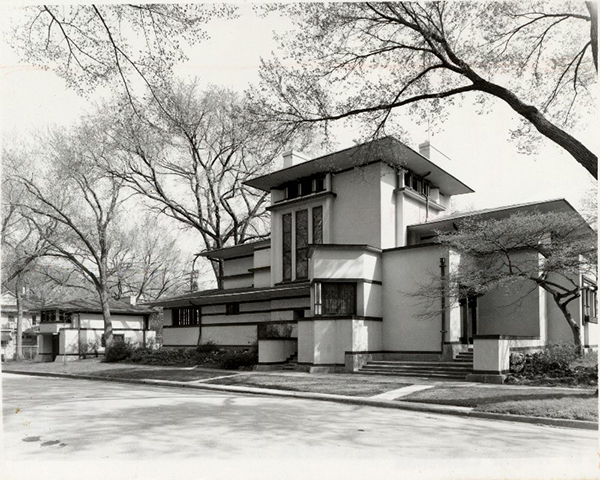Oak Park Public Library
Oak Park has a long and storied history of world-famous authors, architects, and activism for which the Oak Park Public Library—with its community partners—offers stewardship.
 Special Collections at the library include items reflecting the architecture, creativity, and diversity of Oak Park from the late 19th through the 20th Centuries. Core curated historical collections include the Hemingway Archives, Frank Lloyd Wright Collection, Local Authors Collection, Open Housing Movement Archives, and the Scoville Institute Collection. In addition, the Oak Park Local History Collection includes books, oral histories, and the beloved Philander Barclay Photograph Collection: a local bicycling photographer who captured the turn of the last century at the time the Hemingways and Wrights strolled the avenues.
Special Collections at the library include items reflecting the architecture, creativity, and diversity of Oak Park from the late 19th through the 20th Centuries. Core curated historical collections include the Hemingway Archives, Frank Lloyd Wright Collection, Local Authors Collection, Open Housing Movement Archives, and the Scoville Institute Collection. In addition, the Oak Park Local History Collection includes books, oral histories, and the beloved Philander Barclay Photograph Collection: a local bicycling photographer who captured the turn of the last century at the time the Hemingways and Wrights strolled the avenues.
Oak Park Public Library’s social and cultural heritage holdings include photographs, oral histories in audio and video, negatives and slides, drawings, blueprints, architectural renderings, rare books, transcriptions, minutes, and numerous ephemera. The collections are accessible in-person in Oak Park by appointment; with a growing number of items being made available online.
Hemingway Archive
Special Collections maintains a museum-grade vault that includes dedicated space housing the Ernest Hemingway Foundation of Oak Park Hemingway Archive. Ernest Hemingway and his family lived in Oak Park, framing the family collections. Complimenting these is the Oak Park Public Library Hemingway Collection that includes such items as rare editions of Ernest Hemingway’s works, Oak Park River Forest High School homework papers, and a collection of Hemingway childhood photographs.
Frank Lloyd Wright Collection
Oak Park was the home of Frank Lloyd Wright, and as such the library’s collections feature such rare items as a Wasmuth Portfolio (1910) containing 100 lithographs of Wright’s works. Architectural historians have access to The Steiner Index, which indexes Oak Park and River Forest homes (1896-1916); and numerous digital collections feature the works of Wright and other instrumental Chicago-area architects.
Current digital collections include
Edgar Rice Burroughs Collection
Edgar Rice Burroughs first moved to Oak Park in 1910 and lived here for most of the decade. Early in his tenure here, he completed the first of his Tarzan and his Martian stories, and by 1918 the first of the Tarzan movies had been produced. The Oak Park Public Library collects materials relating to him and to his works.
Frank Lloyd Wright Collection
Frank Lloyd Wright moved to Oak Park in 1889. Some of this town's wealthy residents were among his first clients. By 1909, when he left Oak Park, Wright had completed over one hundred fifty buildings. The Oak Park Public Library collects materials relating to him and to his works.
Gillman Lane Collection
The Gilman Lane collection has photographs of the architecture of Frank Lloyd Wright and others in Oak Park, River Forest, and beyond. The photographs were given to the Oak Park Public Library after Mr. Lane's death in 1961.
Grant Manson Collection
The Grant Manson Collection includes photographs of the architecture of Frank Lloyd Wright and others. Mr. Manson took the photographs between 1937 and 1941 while he was researching his doctoral dissertation titled Frank Lloyd Wright's Work Before 1910. Mr. Manson gave the photographs and other materials to the library in July 1973.
William Allin Storrer Collection
The William Allin Storrer Collection includes 2,361 photographs of virtually all of the buildings that Frank Lloyd Wright designed in his career. Mr. Storrer has made it his goal to research, identify, and catalog Frank Lloyd Wright’s buildings, assigning each building a unique number--a Storrer number. His two books, The Architecture of Frank Lloyd Wright: A Complete Catalog and The Frank Lloyd Wright Companion, represent the achievement of that goal. These photographs, which were taken by, or acquired by, Mr. Storrer in compiling his books were given to the library in June 2008.

